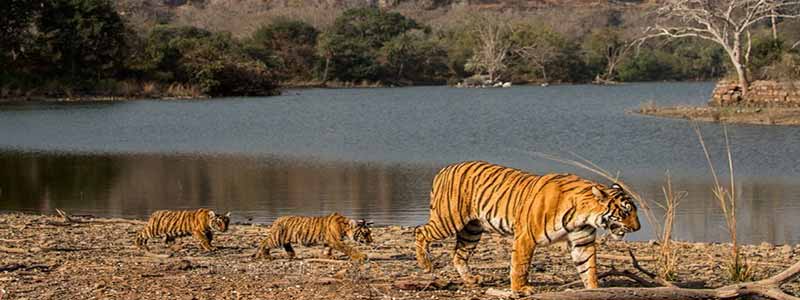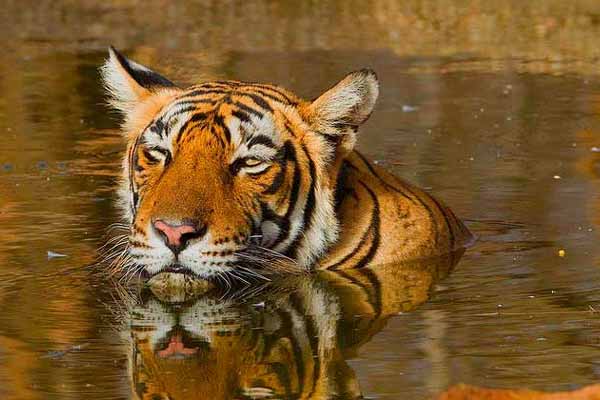Top 5 National Parks in Rajasthan is known as a sunny, arid destination with the popular Thar Desert as well. But the largest state of this India is still very rich in biodiversity and is blessed with a range of vegetation and plenty of species of animals and birds. In reality, Rajasthan is one of India’s top Tiger Sighting and Birdwatching destinations.
The state possesses semi green forests; Mountainous terrain; open grasslands; dry deciduous thorn forest and even wetlands for the survival of biodiverse species. There are about 480 plant and trees species which can be found in Rajasthan. It is also home to a host of national parks, wildlife sanctuaries, and bird sanctuaries making it India’s top wildlife vacation destinations.
Rajasthan offers Ranthambore National Park and Sariska National Park for tiger sighting while UNESCO World Heritage Site Keoladeo National Park along with Tal Chhapar, Van Vihar and Jorbeed make the best destinations in the state for bird watching. The Desert National Park is home to Great Indian Bustard, critically endangered species. Besides these, Rajasthan is Farm to many leopards, blackbucks, great spotted Indian eagles, and marsh crocodiles.

1. Ranthambore National Park – Sawai Madhopur Rajasthan
Ranthambhore National Park Situated between the Aravalis and Vindhyan hill systems in eastern Rajasthan’s Sawai Madhopur district, Ranthambhore National Park (282 sq km) is a part of the much larger Ranthambhore Tiger Reserve (1334 sq km).
The reserve hosts over 40 mammal species, 300 bird species, 45 reptile species and over 300 plant species. But it’s the “relatively simple sightings” of wild tigers that have made Ranthambhore worldwide popular.
The Ranthambhore National Park, part of the much larger Ranthambore tiger reserve, a tiger reserve project, is located in eastern Rajasthan’s Sawai Madhopur district. It is the only forest reserve in the state of Rajasthan and on the whole range of Aravali hills where wild bengal tigers still live. The reserve’s dry deciduous ecosystem makes it much easier to locate and observe tigers in their wild, natural environment.
The Chambal River forms the natural boundary to the east of Ranthambore National Park, And the Central Indian state of Madhya Pradesh falls on the eastern shore of Chambal. The river-Banas, a tributary of Chambal, flows to the northeast of the Ranthambhore National Park. The Keladevi sanctuary lies across the river Banas, while the wildlife sanctuary Sawai Man Singh lies to the south of the park. Both these sanctuaries are part of the Ranthambore tiger reserve along with the Ranthambore national park. Today this tiger reserve project covers more than 1334 sq. Km of land comprising 282 sq. The Ranthambore National Park is located at km.
2. Sariska Tiger Reserve – Alwar Rajasthan
Sariska Tiger Reserve located in Rajasthan’s Alwar district is 107 Km away. Just 200 km from Delhi and from Jaipur. It covers an area of overall 800 sq km, with a core area of about 500 sq km. With its combination of sharp cliffs and deep , narrow valleys, the Northern Aravali Hills dominate the skyline. In 1955 the area was designated a refuge, and in 1979 it became a National Park.
The Sariska Tiger Reserve holds a strong variety of wildlife besides Tiger being the main predator, other animals in the Reserve include, leopard, Hyena, Caracal, Jungle cat, Ratel, Nilgai, Sambar deer, Spotted deer, langur, Rhesus macaque, Four-horned antelope, Wild pig, Indian civet, Rufous tailed hare, Common Mongoose, Ruddy Mongoose, Palm Civet, Pangolin, Porcupine, etc.
There were a total of 211 bird species identified in the reserve. Of which 120 are resident, 73 are migrants and 18 are considered vagabonds. The reserve’s avian population includes peafowl, grey francolin, white-rumped vulture, painted spur fowl, Aravalli red spurfowl, Indian Cuckoo, common sand grouse, Indian pitta, big horned owl, etc.
3. Mukundra Tiger Reserve – Rajasthan
Mukundra Tiger Reserve is now Rajasthan ‘s third tiger reserve, also known in the past as Darrah wildlife sanctuary, located in the southeastern part of Rajasthan’s Kota district. In the past it is the Kota Maharaja Royal Hunting Ground. This place is located approximately 50 km from Kota. It lies on the eastern bank of the river Chambal and its tributaries toches this area.
In 2004 NATIOANL PARK Mukundra Hills Natioanl Park was declared the Darrah wildlife sanctuary. The National Park total area is approximately 200 sqkm. Mukundra Hills National Park contains three wildlife sanctuaries, namely the Darrah Wildlife Sanctuary, the Chambal Wildlife Sanctuary, and the Jaswant Sagar Wildlife Sanctuary In 2013 and then the Rajasthan receives its third tiger reserve in the form of the Mukundra Hills Tiger Reserve, and is now home to four tigers who have recently relocated from the Ranthambore Tiger Reserve here.
4. Kumbhalgarh Wildlife Sanctuary – Rajsamand Rajasthan
A big attraction for visitors coming to Udaipur is the Kumbhalgarh Wildlife Sanctuary. This shrine lies under Rajasthan District of Rajsamand. Kumbhalgarh Park is situated on the Udaipur-Pali-Jodhpur road at a distance of 65 kms. If you’re a fan of nature it’s a great place to explore. Spread over an area of 578 sq km, encircles the Kumbhalgarh Sanctuary The Kumbhalgarh Huge Fort. This wildlife park got its name impregnated from the same castle.
The Kumbhalgarh sanctuary, stretching across the Aravalli Range, covers parts of the districts of Rajsamand, Udaipur and Pali. The sanctuary harbours many endangered wildlife species. Many animals such as Wolf, Leopards, Sloth bear, Hyena, Jackal, Jungle cat, Sambhar, Nilgai, Chausingha (the four horned antelope), Chinkara and Hare are provided with natural abode via the sanctuary. In fact, Kumbhalgarh is Rajasthan’s only sanctuary, where wolf engaged in its activities can be tracked.
More than forty wolves occupy this sanctuary in number. One can easily find pack of wolves in the sanctuary in the summers strolling around water bodies. If you find your interest in birds, a nice range of birds can be seen here too. You can see Gray Jungle Fowl in the park and this is normally stopped. Peacocks and Doves are also gaining attention through their own charm. Besides this, birds such as Red Spur Owls, Parakeets, Golden Oriole, Bulbul, Dove, Grey Pigeons and White Breasted Kingfisher can be found near the holes of water.
Even Kumbhalgarh Sanctuary enjoys a range of flora including many plants and trees with herbal qualities. You can also take a safari trip to enjoy certain birds and animals’ natural environment. For its natural beauty, Kumbhalgarh attracts many visitors to itself each year. In addition, Kumbhalgarh is within easy reach from Udaipur District. You can take regular bus services starting from Udaipur, if you are not interested in taking a bus ride, you can also hire private taxis to visit this sanctuary.
5. Keoladeo Ghana National Park | Bharatpur Rajasthan
In 1971 Keoladeo was designated a bird sanctuary (Bird sanctuary in 1956, unofficially). The bird sanctuary at Keoladeo was declared a National Park in 1981. The total National Park area is approximately 28.7 km2. Under the Wetland Convention in October 1981 Keoladeo Ghana National Park was declared as a Ramsar site.
Keoladeo has been declared a World Heritage Site Under UNESCO World Heritage Convention in 1985. It is a reserve forest under the 1953 Rajasthan Forest Act, and is thus the property of the Indian Union State of Rajasthan.
The park was a hunting ground for Bharatpur’s maharaja, who in 1956 turned their personal hunting domain into a bird sanctuary. Bharatpur’s Maharaja created the sanctuary, constructed a dam and an artificial lake to store the rains that would fall in torrents during the monsoons.
Duck shoots were held annually in honour of the British Viceroys. In one shoot alone in 1938 Lord Linlithgow killed about 4,250 birds. The last major shoot took place in 1964 but up until 1972 the Maharajah held shooting rights. In 1982 village cattle grazing was banned in this area , leading to clashes between government and local farmers.
